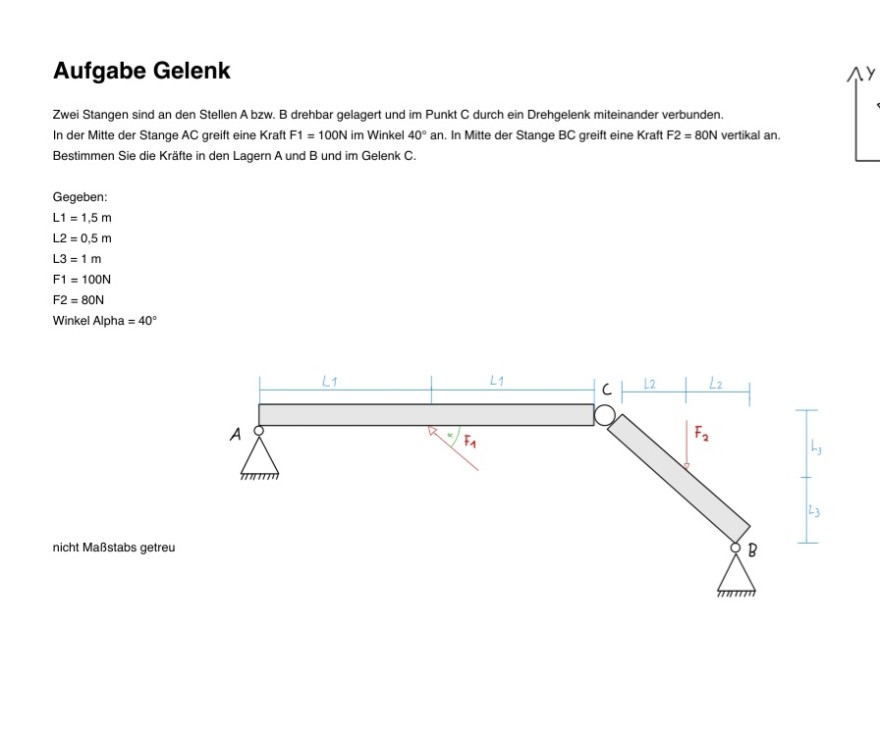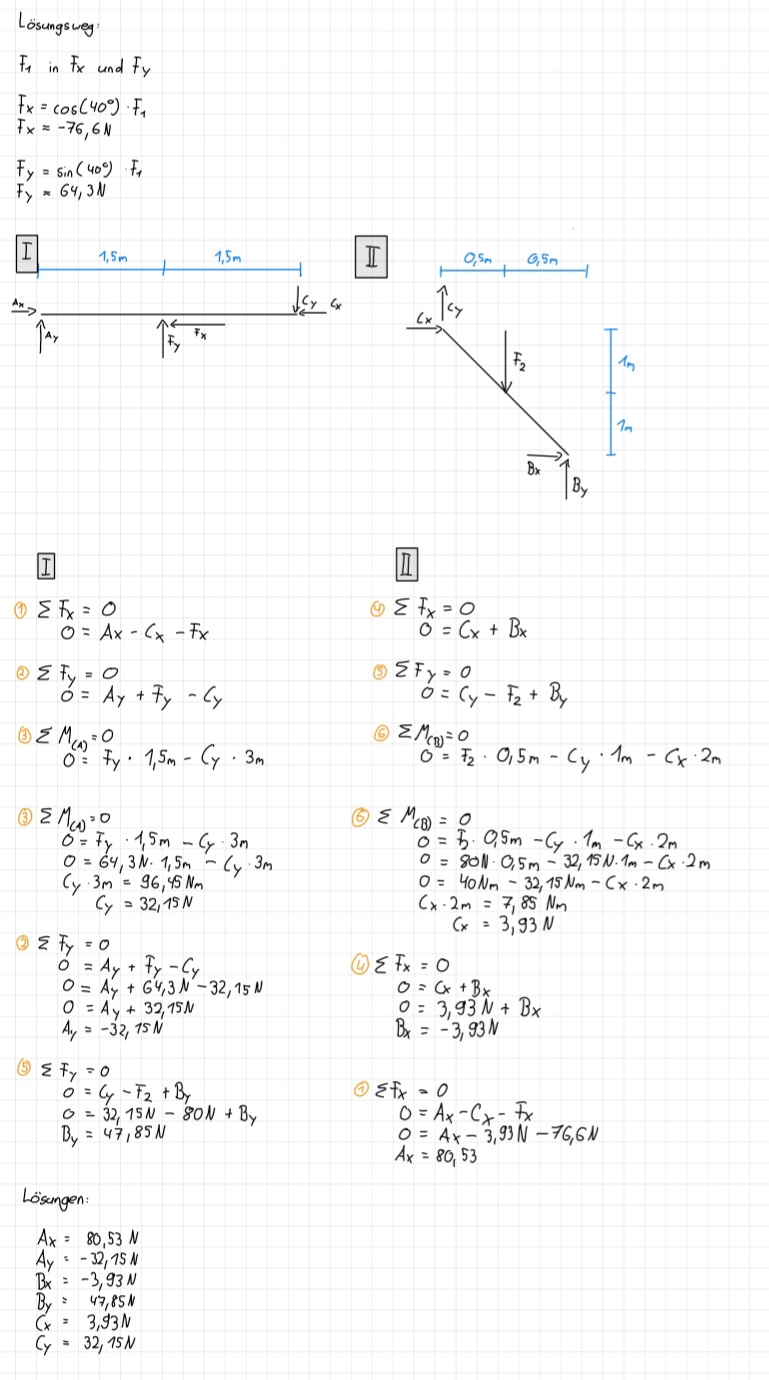Aufgabe:
Problem/Ansatz:
ist das so richtig ausgerechnet?
Text erkannt:
Aufgabe Gelenk
Zwei Stangen sind an den Stellen A bzw. B drehbar gelagert und im Punkt C durch ein Drehgelenk miteinander verbunden.
In der Mitte der Stange AC greift eine Kraft F1 \( =100 \mathrm{~N} \) im Winkel \( 40^{\circ} \) an. In Mitte der Stange BC greift eine Kraft F2 \( =80 \mathrm{~N} \) vertikal an. Bestimmen Sie die Kräfte in den Lagern A und B und im Gelenk C.
Gegeben:
\( \begin{array}{l} \mathrm{L} 1=1,5 \mathrm{~m} \\ \mathrm{~L} 2=0,5 \mathrm{~m} \\ \mathrm{~L} 3=1 \mathrm{~m} \\ \mathrm{~F} 1=100 \mathrm{~N} \\ \mathrm{~F} 2=80 \mathrm{~N} \\ \text { Winkel Alpha }=40^{\circ} \end{array} \)
nicht Maßstabs getreu

Text erkannt:
Lösungswey:
\( F_{1} \) in \( F_{x} \) und \( F_{y} \)
\( \begin{array}{l} F_{x}=\cos \left(40^{\circ}\right) \cdot F_{1} \\ F_{x}=-76,6 \mathrm{~N} \\ F_{y}=\sin \left(40^{\circ}\right) \cdot F_{1} \\ F_{y} \approx 64,3 \mathrm{~N} \end{array} \)
II
(1)
\( \begin{aligned} \Sigma F_{x} & =0 \\ 0 & =A_{x}-C_{x}-F_{x} \end{aligned} \)
(2)
\( \begin{aligned} \sum F_{y} & =0 \\ O & =A_{y}+F_{y}-C_{y} \end{aligned} \)
(3)
\( \begin{aligned} \sum M_{(1)} & =0 \\ 0 & =F_{y} \cdot 1,5_{m}-C_{y} \cdot 3 m \end{aligned} \)
(3) \( \sum M_{(1)}=0 \)
\( \begin{array}{c} O=F_{y} \cdot 1,5 m-C_{y} \cdot 3 m \\ O=64,3 N \cdot 1,5 m-C_{y} \cdot 3 m \\ C_{y} \cdot 3 m=96,45 N m \\ C_{y}=32,15 N \end{array} \)
(2)
\( \begin{aligned} \sum F_{y} & =0 \\ 0 & =A_{y}+F_{y}-C_{y} \\ 0 & =A_{y}+64,3 \mathrm{~N}-32,15 \mathrm{~N} \\ 0 & =A_{y}+32,15 \mathrm{~N} \\ A_{1} & =-32,15 \mathrm{~N} \end{aligned} \)
(5)
\( \begin{aligned} \sum F_{y} & =0 \\ 0 & =C_{y}-F_{2}+B_{y} \\ 0 & =32,15 \mathrm{~N}-80 \mathrm{~N}+B_{y} \\ B_{y} & =47,85 \mathrm{~N} \end{aligned} \)
(4)
\( \begin{aligned} \sum F_{x} & =0 \\ 0 & =C_{x}+B_{x} \end{aligned} \)
(5)
\( \begin{aligned} \sum F_{y} & =0 \\ 0 & =C_{y}-F_{2}+B_{y} \\ \sum M_{(B)} & =0 \\ 0 & =F_{2} \cdot 0,5 m-C_{y} \cdot 1 m-C_{x} \cdot 2 m \end{aligned} \)
(6)
\( \begin{aligned} \Sigma M_{(B)} & =0 \\ 0 & =5 \cdot 0,5 m-C_{y} \cdot 1 m-C_{x} \cdot 2 m \\ 0 & =80 N \cdot 0,5 m-32,15 N \cdot 1 m-C_{x} \cdot 2 m \\ 0 & =40 N_{m}-32,15 N_{m}-C_{x} \cdot 2 m \\ C_{x} \cdot 2 m & =7,85 N_{m} \\ C_{x} & =3,93 N \end{aligned} \)
(4)
\( \begin{aligned} \sum F_{x} & =0 \\ 0 & =C_{x}+B_{x} \\ 0 & =3,93 \mathrm{~N}+B_{x} \\ B_{x} & =-3,93 \mathrm{~N} \end{aligned} \)
(1)
\( \begin{aligned} \sum F_{x} & =0 \\ 0 & =A_{x}-C_{x}-F_{x} \\ 0 & =A_{x}-3,93 \mathrm{~N}-76,6 \mathrm{~N} \\ A_{x} & =80,53 \end{aligned} \)
Lösungen:
\( \begin{array}{l} A_{x}=80,53 \mathrm{~N} \\ A_{y}=-32,75 \mathrm{~N} \\ B_{x}=-3,93 \mathrm{~N} \\ B_{y}=47,85 \mathrm{~N} \\ C_{x}=3,93 \mathrm{~N} \\ C_{y}=32,75 \mathrm{~N} \end{array} \)